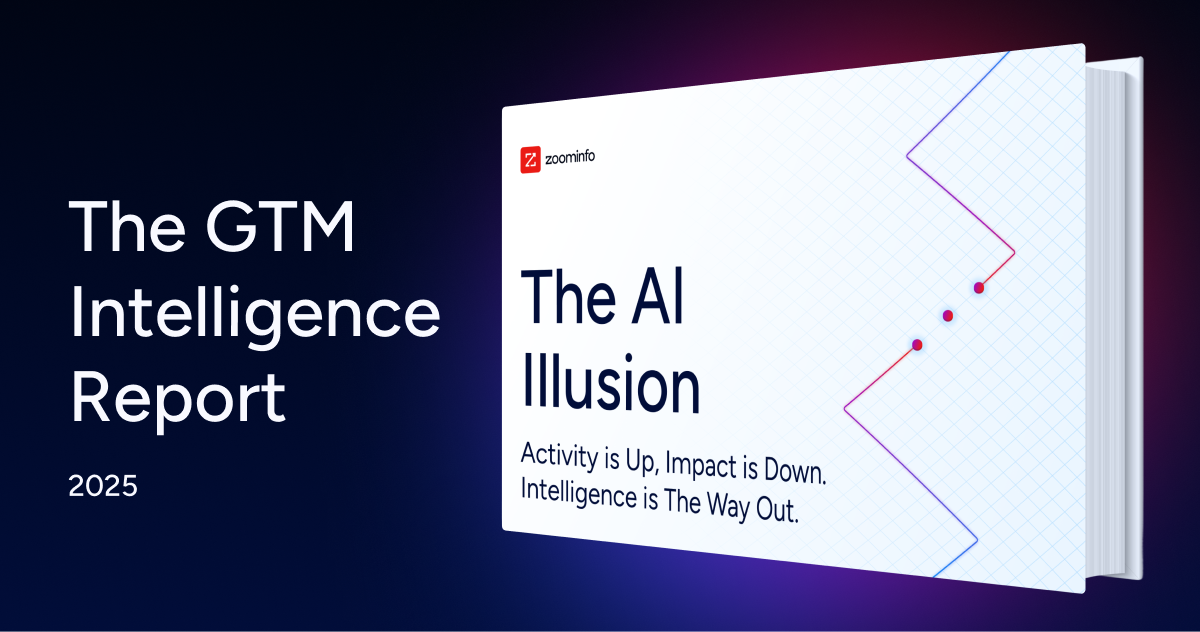B2B revenue teams aren’t struggling because of a lack of tools or automation. They’re struggling because they’ve built systems that are too rigid to respond to how buyers actually behave.
For years, revenue leaders prioritized predictability, building systems, templates, motions, and cadences that could be replicated. While this may have improved returns in the short term, over time it has hindered many go-to-market (GTM) teams’ ability to respond to changing markets, buyers, and behaviors.
The old ways simply no longer work. Industry “best practices” that were once seen as a competitive advantage have become active liabilities, and revenue leaders must adapt if they hope to succeed in increasingly ruthless markets.
ZoomInfo’s 2025 Go-to-Market IntelligenceReport lays this out with proprietary data and expert insights, and gives GTM leaders a blueprint to operate smarter, faster, and more creatively by making intelligence the center of their revenue engine.
Get the Full GTM Intelligence Report Today

GTM is at the Breaking Point
Many modern GTM engines were built for predictability in an era of constant economic growth. But today, they’re creating gridlock. Sales and marketing teams are overwhelmed, and the old reliable methods just aren’t cutting it.
The average GTM stack includes tools from 23 vendors, and teams suffer from siloed systems and poor data quality.
ZoomInfo data reveals that the vast majority of GTM leaders cite poor-quality data as a major barrier to success.
Pipeline stalls and productivity crashes as teams chase volume instead of value.
“GTM is no longer a static plan — it’s a transformation process built to drive outcomes, not just complete tasks.”
AI is Accelerating the Wrong Things
AI use in GTM has grown nearly 900% since 2022. But too many companies are seeing lackluster results because they’re deploying AI on top of broken intelligence infrastructures.
Only 19% of companies believe their data is AI-ready
Companies report under 5% revenue lift from an average $20M annual AI investment
AI technologies have enormous potential for GTM teams, but they’re not the silver bullet many executives believe them to be. Without a strong, reliable foundation of GTM Intelligence, AI will widen and expose the gaps in current GTM strategies.
Top Performers Don’t Follow the Playbook
High-performing sales teams aren’t running better cadences. They’re throwing out the old playbook entirely.
While the approaches of the best GTM teams can be instructive, it’s simply no longer enough for companies to imitate the best sellers in their industries. The “playbook” era is over. Today’s buyers demand more.
The best GTM teams are taking a radically different approach:
Focus relentlessly on customer-facing activities
Prioritize value and timing, not just volume
Use real-time signal data to adapt dynamically in the moment
This is the new mental model: Context over cadence. Creativity over predictability.
Signals Drive Real Results
GTM Intelligence, powered by a universe of high-velocity buying signals, is the force multiplier for elite teams.
Today’s markets move too quickly for even the most sophisticated static plays to keep up. To succeed, revenue leaders must adopt a flexible, creative mindset powered by real-time data and insights.
Some of the world’s biggest brands have achieved remarkable results by abandoning outdated methods and thinking, and embracing responsive, data-driven workflows:
SAP cut its buying cycle by two-thirds and doubled pipeline by using 40+ AI tools to personalize outreach.
ThermoFisher Scientific unlocked $20B in new TAM by rebuilding its ICP using signal data and real-time modeling.
Fortune 500 companies using GTM Intelligence register 5X revenue growth, 89% higher profits, and are 2.5X more valuable than peers.
This isn’t theoretical. These are operationalized outcomes.
“The companies driving breakthrough results in GTM and AI aren’t just adopting AI faster. They’re mastering GTM Intelligence—transforming a raw data deluge into actionable insights.”
What GTM Leaders Need to Do Now
ZoomInfo’s Go-To-Market Intelligence Report reveals the urgent need for today’s businesses to shift from overreliance on rigid, formulaic systems to creative, adaptive execution.
This starts with five core actions:
1. Fix the Foundation
Break down silos. Build a unified signal layer that connects CRM, email, product data, and third-party insights, giving every team a single source of GTM truth across the entirety of your business.
2. Rethink Workflows
Ditch the dashboards. Real-time, signal-based plays should activate in the flow of work, not depend on someone checking a report.
3. Fuel Creativity
Give GTM teams the space and tools to act on emerging whitespace, not just repeat pre-built plays. Creativity is now a core differentiator.
4. Measure What Matters
Shift from volume-based KPIs to outcome-focused metrics: signal velocity, engagement trends, and real buyer readiness.
5. Design for Intelligence
The future GTM system isn’t just automated. It’s adaptive, improvisational, and intelligent by default.
The Bottom Line
The world’s biggest brands don’t win by being the most automated. They win by being keenly attuned to the rapidly changing needs of their customers and modern buyers.
GTM Intelligence is how teams get there, leveraging signal-driven systems, creative execution, and real-time visibility throughout today’s nonlinear, multichannel buying journey.
“With Go-to-Market Intelligence, we’ve achieved a significant boost in marketing campaign performance — the kind of results you only get by leveraging real-time insights.”
The era of the GTM assembly line is over. Intelligence is the new infrastructure.
Download ZoomInfo’s Go-to-Market Intelligence Report 2025 to learn how the most effective B2B brands are meeting the moment, and how your business can do the same.


